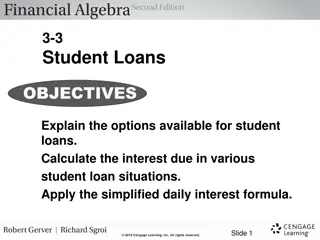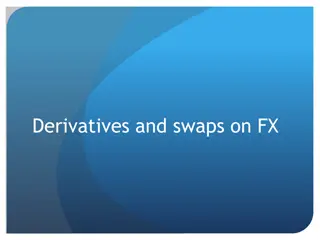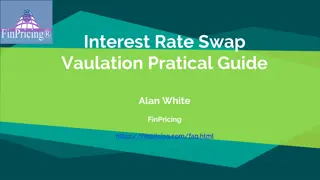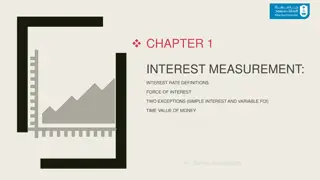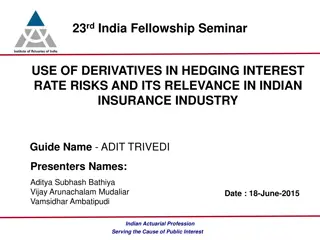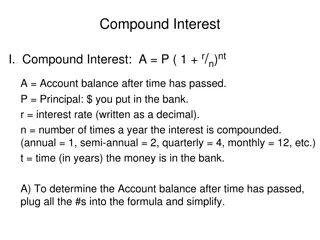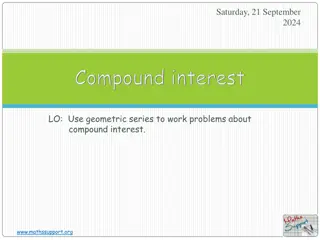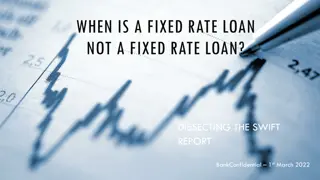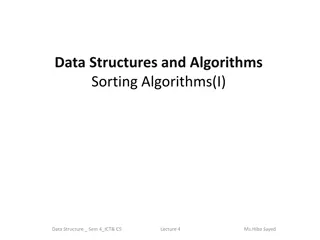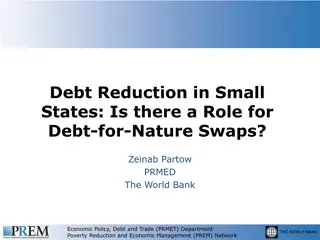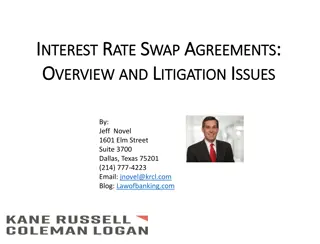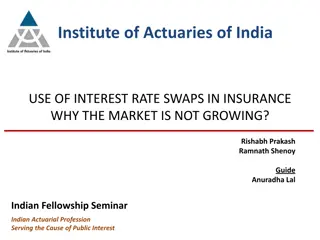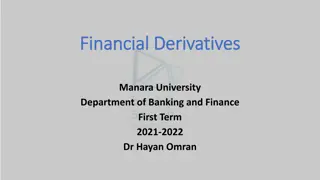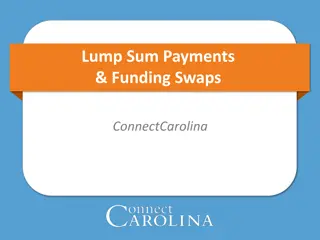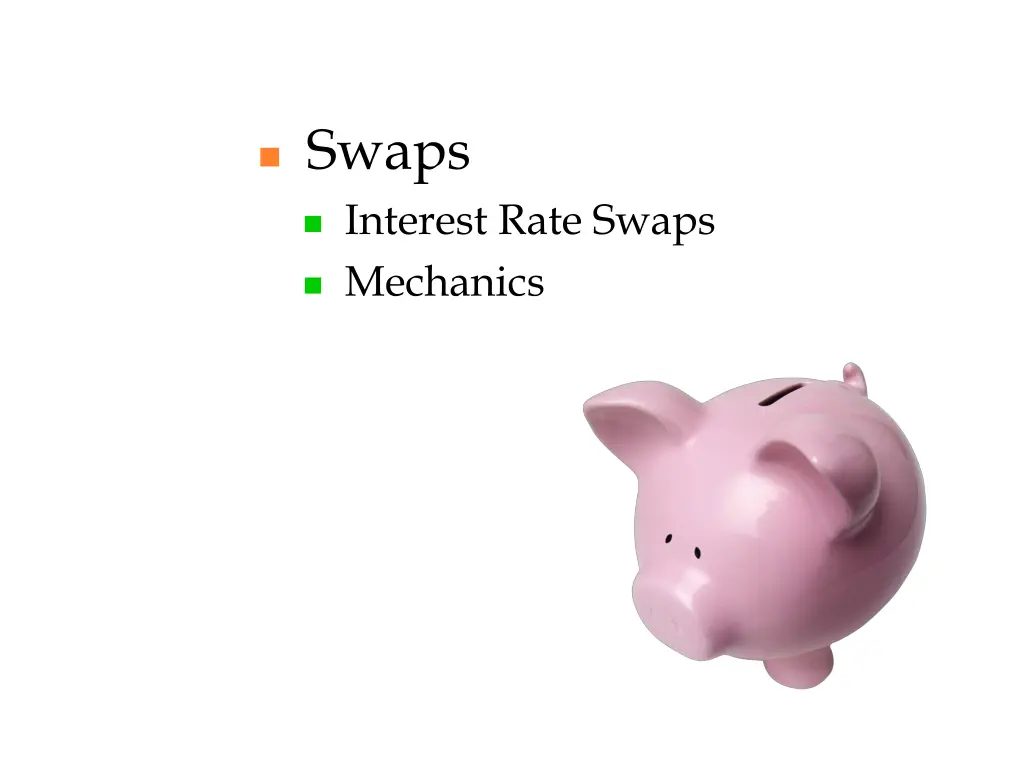
Understanding Interest Rate Swaps and Cash Flows for Effective Risk Management
Explore the mechanics of interest rate swaps, how they help manage interest rate risk, and analyze IBM's cash flows in various interest rate scenarios. Discover the potential impacts of increasing and decreasing interest rates on income and expenses.
Download Presentation

Please find below an Image/Link to download the presentation.
The content on the website is provided AS IS for your information and personal use only. It may not be sold, licensed, or shared on other websites without obtaining consent from the author. If you encounter any issues during the download, it is possible that the publisher has removed the file from their server.
You are allowed to download the files provided on this website for personal or commercial use, subject to the condition that they are used lawfully. All files are the property of their respective owners.
The content on the website is provided AS IS for your information and personal use only. It may not be sold, licensed, or shared on other websites without obtaining consent from the author.
E N D
Presentation Transcript
Swaps Interest Rate Swaps Mechanics
Interest Rate Swaps Now let s turn to another investment vehicle that is used to manage interest rate risk Interest Rate Swaps. Key Factors: Fixed-Rates: Ex: 8.75%, 10%, 12% Variable-Rates (floating): Ex: LIBOR+1%, PRIME +2%
Fixed vs. Variable (floating) Suppose IBM has the following assets and liabilities on its books: Assets: $20 million in variable-rate financing (loans) at LIBOR (London InterBank Offer Rate) +1%, made to customers purchasing IBM computers. Liabilities: $20 million in 5% fixed-rate, annual paying bonds that were issued to fund the above financing program.
Fixed vs. Variable (floating) What do the IBM cash flows look like? Assets: Interest Income (inflow) to IBM dependent upon the interest rate environment. (LIBOR+1%) Liabilities: Interest Expense (outflow) for IBM is fixed, based on the coupon rate of the bonds. (5%) IBM s concerns: What would happen if market interest rates shot up? (Income up, expenses same this is good!) What would happen if market interest rates fell? (Income down, expenses same this is bad!)
IBMs Cash Flows Floating Interest Income Period (years) Fixed Interest Expense Net Interest Flow LIBOR $20 million x (LIBOR +1%) $20 million bonds at 5% coupon, annual Today 1 2 3 4 5 6 4.00% ?? ?? ?? ?? ?? ?? $1,000,000 ?? ?? ?? ?? ?? ($1,000,000) 0 ?? ?? ?? ?? ?? ($1,000,000) ($1,000,000) ($1,000,000) ($1,000,000) ($1,000,000) (4% + 1%)x20 mill = 1 million
IBMs Cash Flows (increasing interest rates) Floating Interest Income $20 mil x (LIBOR +1%) Fixed Interest Expense Net Interest Flow Period LIBOR $20 million bonds at 5% coupon, annual Today 4.00% 1 2 3 4 5 6 4.20% 4.40% 5.00% 5.60% 5.90% 6.40% $1,000,000 ($1,000,000) $0 $1,040,000 ($1,000,000) $40,000 $1,080,000 ($1,000,000) $80,000 $1,200,000 ($1,000,000) $200,000 $1,320,000 ($1,000,000) $320,000 $1,380,000 ($1,000,000) $380,000 End of Period 2 income: (4.2%+1%)x20mill= $1,040,000. Note the delay in the rate change effect.
IBMs Cash Flows (decreasing interest rates) Floating Interest Income $20 mil x (LIBOR +1%) Fixed Interest Expense Net Interest Flow Period LIBOR $20 million bonds at 5% coupon, annual Today 4.00% 1 2 3 4 5 6 3.90% 3.70% 3.50% 3.40% 3.00% 2.90% $1,000,000 ($1,000,000) $0 $980,000 ($1,000,000) ($20,000) $940,000 ($1,000,000) ($60,000) $900,000 ($1,000,000) ($100,000) $880,000 ($1,000,000) ($120,000) $800,000 ($1,000,000) ($200,000) End of Period 2 income: (3.7%+1%)x20mill= $940,000. Note the delay in the rate change effect.
How can IBM match these cash flows? They could refinance their fixed-rate liabilities with floating-rate liabilities: Issue new bonds with a variable rate structure that is similar to that of the assets (LIBOR + 1% assets). Use the proceeds to call the fixed-rate bonds (if callable), or to purchase them in the market to retire them. But, this can be very expensive (flotation costs) and time consuming. Instead, IBM could enter the Swap Market and purchase an investment vehicle, called an Interest Rate Swap, that allows them to, in effect, change a stream of cash flows from fixed to variable (or vice versa).
Swaps Contracts: Definitions In a Swap, two counter-parties agree to a contractual arrangement wherein they agree to exchange cash flows at periodic intervals. Fixed for Floating; Floating for Fixed Only interest payments are swapped. No Principal is exchanged Single currency interest rate swap Plain vanilla fixed-for-floating swaps are often just called interest rate swaps.
Swaps Contracts: Definitions Notional Amount: Amount used to calculate the swapped interest payments. Fixed-rate payer (buyer): Person who pays fixed is always the buyer Floating-rate payer (seller): Person who pays floating is always the seller Reset Date: When the floating rate changes Counterparty-risk: Risk that one party might default. Party who is left will have to find a new counterparty at prevailing swap rates.
The Swap Bank A Swap Bank is a generic term to describe a financial institution that facilitates Swaps between counter-parties. The Swap Bank can serve as either a broker or a dealer. As a broker, the Swap Bank matches up counter-parties but does not assume any of the risks of the swap. As a dealer (market-maker), the Swap Bank stands ready to accept either side of a swap. They, in fact, are then the counter-party and they assume risk. Later, they can match the swap with another counter-party to alleviate exposure to counterparty risk.
How do Swap Banks make their money? They can charge a commission if they act as a broker (they take on no counter-party risk). They just match up Firm A and Firm B that have offsetting cash flow needs (fixed vs. floating). (ex: match IBM with a firm with opposite floating vs. fixed rate needs) They can act as a dealer and actually play the role of counter-party on a SWAP. They set the swap rates so that they expect to earn a profit if they are the counter party for both sides. (ex: Swap Bank enters into swap directly with IBM)
Lets get back to IBMs problem Currently: $20,000,000 fixed-rate liabilities, 5% fixed outflows $20,000,000 floating-rate assets, LIBOR+1 inflows What if IBM entered into a transaction whereby they could . Receive 5% fixed inflows on $20 million (in exchange for ) Paying LIBOR+1 outflows on $20 million This is what a SWAP could accomplish.
IBMs Cash Flows with a SWAP Current Sell a SWAP (pay floating, receive fixed) SWAP Floating Expense Assets/Liabilities Floating Interest Income Fixed Interest Expense Net Interest Flow Period (years) SWAP Fixed Income LIBOR $20 million bonds at 5% coupon, annual 5% on $20,000,000 notional amount $20mil* (LIBOR +1%) $20mil* (LIBOR +1%) 0 4.00% 1 2 3 4 5 6 ?? ?? ?? ?? ?? ?? $1,000,000 ?? ?? ?? ?? ?? ($1,000,000) $1,000,000 ($1,000,000) ?? ?? ?? ?? ?? $0 ($1,000,000) $1,000,000 $0 ($1,000,000) $1,000,000 $0 ($1,000,000) $1,000,000 $0 ($1,000,000) $1,000,000 $0 ($1,000,000) $1,000,000 $0
An Example of an Interest Rate Swap Consider this example of a plain vanilla interest rate swap. Bank A (not a swap bank) is a AAA-rated U.S. bank that has raised $10,000,000 in fixed-rate coupon-paying bonds to finance floating-rate mortgage loans. Bank A used 5-year fixed-rate coupon bonds at 10%. Due to changes in the interest rate environment, Bank A wants to have floating-rate notes at LIBOR to finance their floating-rate mortgage loans. Bank A could refinance its debt by reissuing $10 million in floating LIBOR bonds (and pay associated flotation costs).
An Example of an Interest Rate Swap Firm B is a BBB-rated U.S. company that needed $10,000,000 to finance an investment with a five- year economic life. Firm B used 5-year floating-rate notes at LIBOR + %. Firm B wants to manage their risk by changing their liabilities to a fixed-rate structure. With their credit rating, they can get 5-year fixed rate coupon bonds at 11.75%. Firm B could refinance its debt by issuing $10 million fixed 11.75% coupon bonds (and pay associated flotation costs).
An Example of an Interest Rate Swap The borrowing opportunities of the two firms are: Bank A Firm B LIBOR + % Floating 10% Fixed Currently has LIBOR Floating Would like/ Could Get 11.75% Fixed
A Swap Bank comes along The Swap Bank makes this offer to Bank A: Swap Bank 10 3/8% You pay LIBOR 1/8 % per year on $10 million for 5 years and we will pay you 10 3/8% on $10 million for 5 years (a swap). LIBOR 1/8% Bank A Swap bank is the Buyer Is this a good offer for Bank A?
Bank As Borrowing Position SWAP Fixed Income SWAP Floating Expense Current Fixed Interest Expense Period (years) Net Borrowing Rate 10 3/8% on $10,000,000 notional amount $10 million notional amount x (LIBOR -1/8%) $10 million bonds at 10% coupon, annual 0 1 2 3 4 5 (10%) 10.375% (LIBOR 0.125%) (LIBOR 0.50%) (10%) 10.375% (LIBOR 0.125%) (LIBOR 0.50%) (10%) 10.375% (LIBOR 0.125%) (LIBOR 0.50%) (10%) 10.375% (LIBOR 0.125%) (LIBOR 0.50%) (10%) 10.375% (LIBOR 0.125%) (LIBOR 0.50%) Net Cost Bank A Firm B Pay Pay 10% LIBOR+ % Floating Currently has LIBOR-0.125% (10.375%) LIBOR 0.50% 10% Fixed Receive Net Cost Would like/ Could Get LIBOR Floating 11.75% Fixed
Bank A Summary Swap Here s what s in it for Bank A: They borrow externally at 10% fixed and have a net borrowing position of : Bank 10 3/8% [LIBOR 1/8] +10- 10 3/8 = LIBOR % LIBOR 1/8% Bank A which is % better than they can borrow floating without a swap. 10% % of $10,000,000 = $50,000. That s quite a cost savings per year for 5 years as opposed to refinancing. Not to mention the flotation costs that were avoided.
Now the Swap Bank talks to Firm B The Swap Bank makes this offer to Firm B: Swap Bank 10 % You pay us 10 % fixed per year on $10 million for 5 years and we will pay you LIBOR % per year on $10 million for 5 years (a swap). LIBOR % Firm B Is this a good offer for Firm B? Firm B is the Buyer
Firm Bs Borrowing Position SWAP Floating Income SWAP Fixed Expense Net Current Floating Int. Expense Period (years) Borrowing Rate $10 million bonds at LIBOR+1/2% $10 million notional x (LIBOR - %) $10 million notional amount x 10 % 0 1 2 3 4 5 LIBOR 0.25% (10.50%) (LIBOR + 0.50%) (11.25%) LIBOR 0.25% (10.50%) (LIBOR + 0.50%) (11.25%) LIBOR 0.25% (10.50%) (LIBOR + 0.50%) (11.25%) LIBOR 0.25% (10.50%) (LIBOR + 0.50%) (11.25%) LIBOR 0.25% (10.50%) (LIBOR + 0.50%) (11.25%) Net Cost LIBOR + 0.50% 10.50% (LIBOR 0.25%) 11.25% Bank A Firm B Pay Pay LIBOR+ % Floating Currently has 10% Fixed Would like/ Could Get LIBOR Floating Receive Net Cost 11.75% Fixed
Firm B Summary Swap Bank Here s what s in it for Firm B. They borrow externally at LIBOR + % and have a net borrowing position of 10 % LIBOR % LIBOR + % Firm B 10 + [LIBOR + ] [LIBOR - ] = 11.25% which is % better than they can borrow fixed. % of $10,000,000 = $50,000. That s quite a cost savings per year for 5 years as opposed to refinancing. Not to mention the flotation costs that were avoided.
What about the Swap Bank? The Swap Bank makes money too. Swap Bank 10 3/8% 10 % LIBOR 1/8% LIBOR % Bank A Firm B Revenues - Expenses % of $10 million = $25,000 per year for 5 years. [LIBOR 1/8%] [LIBOR % ] = 1/8% 10 - 10 3/8 = 1/8% =1/4 %
Everybodys happy The Swap Bank makes % Swap Bank 10 3/8% 10 % LIBOR 1/8% LIBOR % Firm Bank LIBOR + % 10% B A Firm B saves % and matches up fixed assets with fixed liabilities Bank A saves % and matches up floating assets with floating liabilities
Swap Quotes How is the fixed part of a Swap quoted by the dealer? Based on the 5-year Treasury Note rate and LIBOR 50 75 means that the Swap Bank is willing to buy a Swap (pay fixed) for T-note rate + 50 basis points, and/or sell a Swap (received fixed) for T- note rate + 75 basis points. If the current T-note rate is 10%, the 50-75 quote would mean the Swap Bank would pay fixed at 10.50% for LIBOR and receive fixed at 10.75% for LIBOR. It is easy enough to add or subtract basis points from each side as needed.
What was the Fixed Quote for the Swap Bank in our example? Swap Bank 10 3/8% 10.5% LIBOR 1/8% LIBOR % Firm Bank LIBOR + % 10% B A Suppose the 5-year T-note rate was 10%... Pay 10.50% and Receive 10.75% on LIBOR (50 75 quote). Subtract 1/8% from each side with bank A. Subtract % from each side with bank B
Swap Example (Part 1): Hi-Gear, Inc., a manufacturer of sportswear recently issued a 10-year, $5 million bond issue. The bond requires a fixed rate of 8.5% per year (annual payments). The CFO of Hi-Gear would prefer to have a floating- rate liability. The CFO decides to hedge by entering into an interest rate swap, where the firm would receive fixed and pay floating. The Swap dealer quotes 10- year Swaps as LIBOR based, 80-87 . The current 10 year Treasury Bond yield is 7%.
Hi-Gears Borrowing Environment (Receive fixed and pay floating. The Swap dealer quotes 10-year Swaps as LIBOR based, 80-87 .) Fixed 7.8% Swap Bank Hi-Gear, Inc. Floating (LIBOR) Questions: 8.5% Fixed Who is the buyer? The Swap Bank What is the net borrowing position of Hi-Gear, Inc.? Current Bond Holders Net Cost Pay Pay 8.5% LIBOR (7.80%) LIBOR +0.70% Receive Net Cost
Swap Example (Part 2): Lo-Gear, Inc., a manufacturer of sportswear recently issued a 10-year, $20 million bond with a LIBOR + 2% floating rate. The CFO of Lo-Gear would prefer to have a fixed- rate liability. The CFO decides to hedge by entering into an interest rate swap, where the firm would receive floating and pay fixed. The Swap dealer quotes 10- year Swaps as LIBOR based, 80-87 . The current 10 year Treasury Bond yield is 7%.
Lo-Gears Borrowing Environment (Receive floating and pay fixed. The Swap dealer quotes 10-year Swaps as LIBOR based, 80-87 .) Floating LIBOR Swap Bank Lo-Gear, Inc. Fixed 7.87% Questions: LIBOR +2% Who is the buyer? Lo-Gear What is the net borrowing position of Lo-Gear, Inc.? Current Bond Holders Net Cost Pay Pay LIBOR +2% 7.87% (LIBOR) 9.87% Receive Net Cost
Basis Swap (Used to effectively change the base of a floating loan) Receive PRIME-3% Swap Bank GE Pay LIBOR Suppose GE currently has a loan outstanding that is PRIME + 2%. PRIME +2% A Basis Swap can change the base of its floating rate loan from PRIME to LIBOR. Example: Pay LIBOR, Receive PRIME 3% Current Bond Holders Net Cost Pay Pay PRIME +2% LIBOR (PRIME-3.0%) LIBOR +5.0% Receive Net Cost


